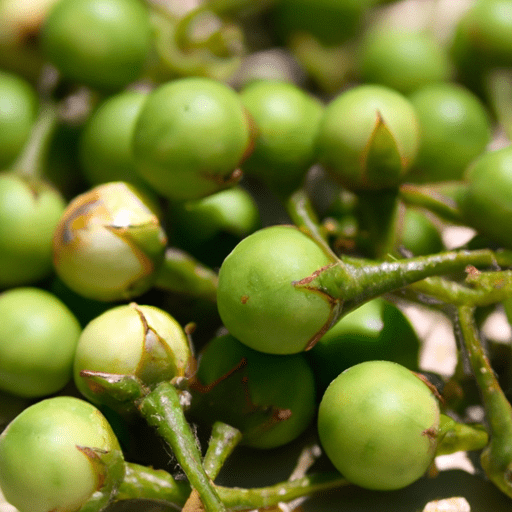Exploring the Flavorful Delights of Turkey Berry
When it comes to exploring the rich diversity of ingredients used in cooking, the world is full of delightful surprises. One such hidden gem is the Turkey Berry. Often overlooked, this small, intriguing fruit adds a burst of unique flavor to numerous culinary dishes. In this blog post, we will dive into the world of Turkey Berry, exploring its taste, common uses in cooking, nutritional value, and some interesting historical facts.
Taste and Texture Profile
Turkey Berry, also known as Pea Eggplant or Sundakkai, is a small, round fruit that is primarily green in color, resembling a miniature eggplant. Despite its small size, the Turkey Berry packs a punch of flavor. It has a tangy, somewhat bitter taste with a hint of sweetness that comes through when cooked. The texture is crisp and slightly firm, similar to cherry tomatoes. When eaten raw, the taste might be too sharp for some palates, but when cooked, it brings a unique depth to various dishes.
Common Uses in Cooking
In many Southeast Asian and African countries, Turkey Berry is an essential ingredient in traditional cooking. Its robust flavor blends harmoniously with a variety of spices, making it a versatile addition to many dishes. Here are some of the popular ways Turkey Berry is used in culinary adventures:
1. Curries and Stews
Turkey Berry is often incorporated into curries and stews to infuse a distinct tanginess into the dish. Its unique flavor complements the richness of the spices, creating a delightful harmony. It is commonly used in popular Indian dishes like sambar (a lentil-based vegetable stew) and rasam (a tangy tomato broth).
2. Pickles and Chutneys
Due to its robust taste, Turkey Berry is also ideal for pickling. In South Indian cuisine, it is pickled to create a tangy and spicy condiment known as Sundakkai Vathal. It adds a zesty kick when served alongside rice, lentils, or even as a side to yogurt-based dishes. Additionally, Turkey Berry chutneys are popular, offering a burst of flavors that elevate everyday meals.
3. Stir-Fries and Sauteed Dishes
When lightly sautéed or stir-fried, Turkey Berry retains its crisp texture and infuses a delightful tangy note into the dish. It pairs well with other vegetables, seafood, or meat, adding depth and complexity to the overall flavor profile. Its versatility makes it a fantastic addition to your stir-fry repertoire.
Nutritional Value
Apart from its culinary prowess, Turkey Berry also brings a range of nutritional benefits:
- It is rich in dietary fiber, aiding in digestion and providing a feeling of fullness.
- It contains valuable phytochemicals that possess antioxidant properties, supporting overall health and well-being.
- Turkey Berry has been traditionally used for its medicinal properties, believed to have anti-inflammatory, anti-diabetic, and antimicrobial effects.
While Turkey Berry may not be widely known or readily available in certain regions, it is worth exploring for its unique flavor and health benefits.
Interesting Facts and History
Turkey Berry has a fascinating history and has been cherished in traditional practices for centuries. Here are some interesting facts and tales:
- Native to Africa and parts of Southeast Asia, Turkey Berry has been extensively used in Ayurvedic and traditional medicine for its healing properties.
- The name “Turkey Berry” is believed to have originated from the fruit’s resemblance to a small wild turkey egg.
- In Ghana, Turkey Berry is a popular ingredient in soups and stews and is believed to enhance fertility.
- In folklore, the Turkey Berry plant is said to possess protective qualities and ward off evil spirits.
Conclusion
Don’t let the modest appearance of Turkey Berry fool you – this underappreciated fruit has the power to elevate your culinary creations with its tangy, slightly bitter flavor. Whether used in curries, pickles, stir-fries, or chutneys, Turkey Berry offers a unique taste experience. So, next time you’re feeling adventurous in the kitchen, consider adding this little treasure to your repertoire. Dive into the world of Turkey Berry and unlock a whole new dimension of flavors!
Turkey Berry
Origin: Turkey berry, also known as Solanum torvum, is native to Southeast Asia. It is commonly found in countries like India, Thailand, Myanmar, Indonesia, and the Philippines.
Common Uses: Turkey berry is widely used in various cuisines across Southeast Asia. It is a popular ingredient in Thai, Indonesian, and Indian cuisine. The berries are usually cooked and incorporated into curries, sambals, stews, and stir-fries. They can also be pickled or dried and used as a spice in different dishes.
Nutritional Benefits: Turkey berry is a good source of several nutrients. It is low in calories and high in fiber, making it beneficial for digestive health. Additionally, it contains vitamins A, C, and E, which are antioxidants that help protect cells against damage. Turkey berry also contains minerals like potassium, calcium, and iron.
Unique Properties: Turkey berry has a distinctive bitter taste, which adds complexity to dishes. Its bitterness is due to the presence of alkaloids, especially solasodine. The berries also have a slightly tangy and sour flavor. Besides culinary uses, turkey berry has been used in traditional medicine for its potential anti-inflammatory and anti-diabetic properties.
Historical Significance: Turkey berry has a long history of use in traditional medicine systems. In Ayurveda, the traditional medicine system of India, it has been used to treat various conditions like fever, cough, asthma, and digestive disorders. In some Southeast Asian cultures, turkey berry is also believed to have protective properties against evil spirits.




Use the share button below if you liked it.
It makes me smile, when I see it.